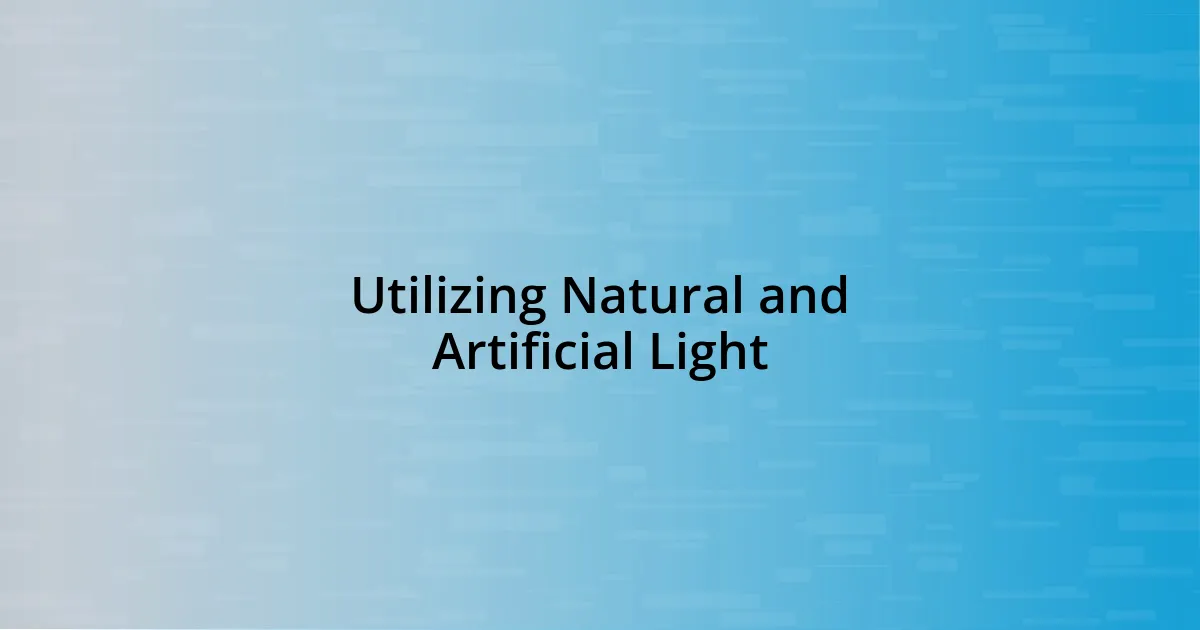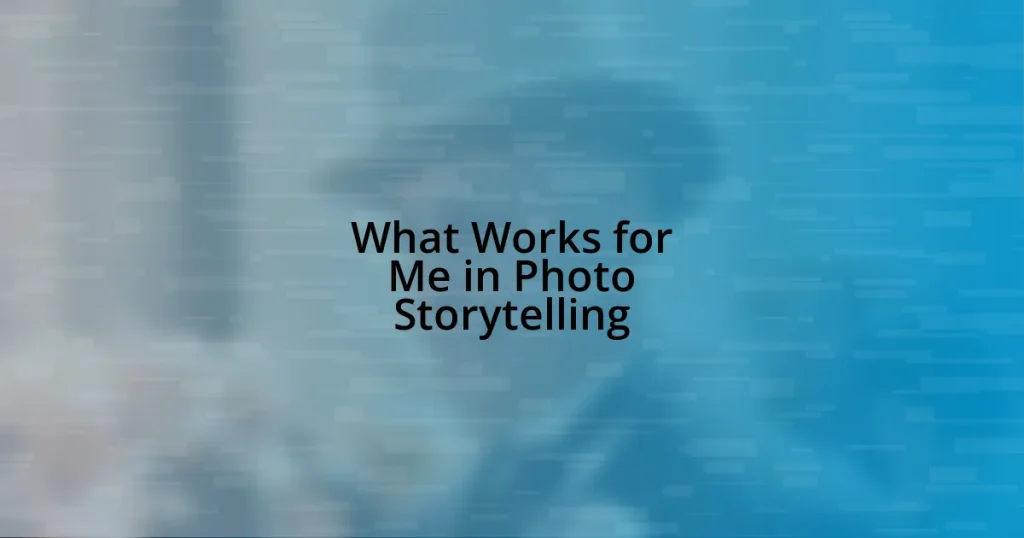Key takeaways:
- Urban photography captures the essence of city life through architecture, people, and creativity.
- Lighting, composition, and equipment selection are crucial for enhancing urban photography quality.
- Finding unique perspectives and incorporating elements like reflections and human interaction adds depth to images.
- Editing plays a vital role in amplifying the emotional impact of urban photographs, helping to refine narratives.

Understanding Urban Photography Basics
Urban photography is all about capturing the essence of city life, showcasing its unique character through architecture, people, and the stories that unfold on the streets. One of my favorite moments came when I stumbled upon an alleyway filled with vibrant street art. The colors and textures told a story that made me feel connected not just to the art, but to the city itself—what a powerful reminder of how creativity thrives in urban spaces!
Lighting plays a crucial role in urban photography. If you’ve ever tried to photograph a bustling street during the golden hour—the time just before sunset—you’ll know how the soft, warm tones can transform a regular scene into something magical. Have you ever noticed how shadows dance across buildings or how reflections in windows can create intriguing patterns? I often find myself wandering, camera in hand, waiting for the perfect moment when the light hits just right.
Another aspect to consider is composition, which can make or break your shot. I remember a time when I was trying to capture a busy intersection. I found that by utilizing the rule of thirds, I could emphasize the rhythm of the city—the figures crossing, the cars moving, and the buildings standing tall. This not only added depth to my photograph but also made the viewer feel like they were a part of the scene. Isn’t it fascinating how a simple shift in perspective can make such a difference?

Choosing the Right Equipment
Choosing the right equipment for urban photography can dramatically enhance your shooting experience. For me, selecting a lightweight mirrorless camera has been a game-changer—it allows for swift maneuvering through crowded spaces while still delivering excellent image quality. When I first switched from a bulky DSLR, I felt liberated, capturing candid moments without feeling weighed down.
Lenses also play a crucial role in urban photography. A versatile zoom lens, like a 24-70mm, is often my go-to because it adapts to various scenes, from vibrant street performers to towering skyscrapers. On one memorable day, I found the right focal length made it easier to capture both people and architecture seamlessly, offering a narrative without needing to change lenses continuously. Have you noticed how the right lens creates a connection to your surroundings?
Finally, consider accessories like a sturdy tripod or a portable reflector. They might seem less essential, but having reliable support on those dusk shoots has helped me achieve stunning long-exposure shots without any camera shake. I once propped my camera on a low wall to catch city lights twinkling against the night sky—without that support, that moment could have been lost.
| Equipment | Benefits |
|---|---|
| Camera | Lightweight, high quality, easy to carry |
| Lens (24-70mm) | Versatile for various subjects, great for storytelling |
| Tripod | Stability for low-light conditions, allows for long exposures |

Finding Unique Urban Perspectives
Finding unique perspectives in urban photography is an exhilarating journey. I often venture off the beaten path, exploring narrow sidestreets or hidden courtyards. One unexpected discovery happened when I was exploring an abandoned building. Peering through a broken window, I was captivated by the way sunlight streamed in, casting intricate shadows on the crumbling walls. It made me realize just how much the unexpected has to offer—nature reclaiming space, urban decay, and fleeting moments that might go unnoticed.
To truly explore unique urban perspectives, consider these approaches:
- Get Low or High: Changing your angle can breathe new life into a scene. Kneeling down can highlight foreground elements, while climbing higher (if safe) can provide a bird’s-eye view.
- Focus on Details: Look for small, intriguing features like cracks in pavement, graffiti textures, or weathered signs. They tell stories that can often be overlooked.
- Play with Reflections: Glassy surfaces can distort and reflect scenes in surprising ways. I remember capturing the mirrored skyline in a puddle after rain—what a dreamlike effect it created!
- Shoot Through Objects: Framing your subject with elements in the foreground, like tree branches or fences, adds depth and layers to your photographs.
- Blend Human Elements: Incorporating people into your shots can add a unique dynamic. I once caught a passerby admiring a mural, which infused life into what would have otherwise been just an artwork.
Every urban space has its hidden gems; you just need to dig a little deeper to find them.

Mastering Composition Techniques
Mastering composition techniques is essential for elevating your urban photography. One of my favorite methods is the rule of thirds—dividing the frame into a grid and positioning your subject along the lines or intersections. I remember a day in the bustling streets of a city when I applied this concept to a vibrant street market. By placing the vendor off-center, I drew attention to the colorful produce around them, creating a narrative that fully captured the scene’s energy. Have you tried this technique? It could transform the way you see your shots!
Another powerful composition technique is leading lines. I often find myself searching for pathways, roads, or even shadows that guide the viewer’s eye toward the main subject. There was this one instance where I shot an empty alleyway lined with graffiti. The lines of the pavement naturally led to an intriguing mural at the end. The moment I captured it, I could almost feel the story of the city being told; it’s like a visual journey unfolds. What stories can your leading lines reveal?
Don’t underestimate the power of negative space either. Allowing empty space around your main subject can evoke emotion and attention. I once framed a solitary figure walking down a long, desolate street during sunset. The emptiness around them amplified the feeling of solitude, making the image resonate more strongly with viewers. Have you noticed how sometimes less truly is more? Experimenting with these techniques can bring a new depth to your images that might surprise you.

Utilizing Natural and Artificial Light
Utilizing light can truly transform your urban photography. I remember one rainy afternoon when I decided to venture out just as the sun began to set. The wet pavement acted like a mirror, reflecting the rich colors of the sky while the soft glow of street lamps started to flicker on. It was a perfect blend of natural and artificial light that created a mood I can only describe as magical. Have you experienced that delightful moment when light seems to wrap around your subject? It’s moments like these that make you appreciate the power of light in photography.
When working with natural light, I find that timing is crucial. Golden hour, shortly after sunrise or before sunset, provides a warm, flattering light that works wonders on urban scenes. I once captured a serene shot of a busy intersection where the soft hues of dusk quietly enveloped the chaos. The incongruity of the hectic city life bathed in gentle light tells a story of coexistence; it’s a surreal calm amidst the storm. Have you ever noticed how the atmosphere changes as the day transitions into night? The way light transforms our surroundings can evoke emotions we didn’t even know we had.
Conversely, don’t shy away from experimenting with artificial light. Neon signs and illuminated windows can add vibrant pops of color and intrigue to your images. I vividly recall a night-time stroll through the city when the glow of storefronts contrasted beautifully against the dark sky. I paused to capture a candid of a couple enjoying a late-night snack outside a food truck, illuminated by the warm glow of its lights. The late-night urban vibe flourished in that snapshot, making me wonder: how can artificial light bring out the personality of your surroundings? I encourage you to explore these diverse lighting conditions; each offers a unique narrative waiting to unfold.

Editing Urban Photography for Impact
Editing plays a crucial role in amplifying the impact of urban photography. I distinctly remember a time when I edited a photo of a crowded subway station; I reduced the colors to a cooler palette and boosted the contrast, which transformed the mundane scene into a gritty, cinematic experience. Have you ever felt that a single edit can turn a simple shot into something evocative and profound? Those subtle adjustments can elicit emotions you didn’t initially capture.
When it comes to enhancing urban shots, I tend to focus on clarity and sharpness. I once took a close-up of a worn-out mural plastered on a brick wall. By applying a slight sharpen filter and adjusting the brightness, the vivid colors popped against the stark backdrop, telling a story of resilience amidst decay. It’s fascinating how sometimes, just a bit of clarity can invite the viewer to lean in closer and appreciate the details. How much have you considered the role of minor edits in bringing your images to life?
Don’t underestimate the power of cropping either. One of my favorite tricks is to remove distractions from the edges of my frame. There was this dynamic shot of street performers I captured, teeming with joyful chaos. After cropping, I centered the performers and removed excess background noise, plunging the viewer directly into their vibrant energy. It’s incredible how a few well-placed clicks can sharpen your focus on the essence of the photo, isn’t it? By exploring these editing techniques, you can truly refine your urban narratives.

Sharing Your Urban Photography Online
Sharing your urban photography online is an exhilarating experience that connects you with others who appreciate the art form. The first time I posted one of my city skyline shots, I was anxious, wondering how people would react. But the rush of engagement and the mix of positive feedback told me I was part of a vibrant community that celebrates each other’s work. Have you shared your favorite shot yet? It can be surprisingly rewarding!
Utilizing social media platforms extends beyond mere likes—it’s about storytelling. When I shared a black and white photo of a grungy alleyway that I stumbled upon, I added a caption detailing my thoughts on urban graffitis’ conversations with the city. That piece not only got likes but sparked discussions, giving me the chance to interact with other photographers and urban explorers. Isn’t it fascinating how a simple image can invite dialogue and connections?
When you post your work, consider the timing and approach for maximum visibility. I’ve found that sharing during peak hours, like early evenings when people unwind, increases engagement. The day I decided to share a sunset shot of busy city streets during rush hour was a breakthrough moment; the photo resonated with so many who could relate to the feeling of being lost in the crowd. Have you thought about how the timing of your posts can create resonance with your audience’s experiences? Engaging the world through your lens can turn mere images into shared narratives that truly resonate.
















